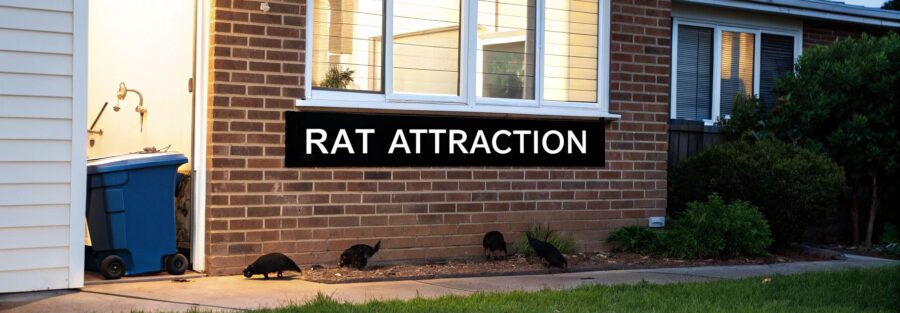It's a simple, and often frustrating, truth: rats are drawn to your house for three basic reasons – food, water, and shelter.
These survival essentials can turn even the most spotless property into a five-star resort for rodents. A forgotten bag of pet food in the garage, a dripping tap in the garden, or a tiny gap in your brickwork is all it takes to send an open invitation.
Why Your Home is the Perfect Target for Rats
To get a handle on rat prevention, you need to start thinking like a rat. Their world is driven by instinct and opportunity, not a desire for dirty homes. A well-kept house with an unsecured rubbish bin is just as tempting as a cluttered shed if it offers a reliable meal.
This isn't a rare problem. In the UK, local authorities are fielding pest calls every two minutes, and rodents are the culprits in a staggering 91% of these cases.

As you can see, food is by far the biggest draw. Once they find a consistent food source, they'll look for a safe place to nest and a water supply to wash it all down.
The Survival Triangle: Food, Water, and Shelter
These three elements form what we call the "survival triangle." If a rat can find all three in one place, it has no reason to move on and every reason to start a family.
To help you identify potential weak spots, here’s a quick summary of the main attractants and where you'll usually find them.
Primary Rat Attractants and Common Household Sources
| Attractant | Common Household Sources |
|---|---|
| Reliable Food Supply | Unsecured bin bags, pet food bowls left out, bird feeders, compost heaps, fallen fruit, and food spillages. |
| Secure Shelter | Wall cavities, cluttered lofts or basements, under decking, inside sheds, overgrown gardens, and woodpiles. |
| Consistent Water Access | Leaky outdoor taps, puddles, pet water bowls, blocked drains, saucers under plant pots, and even condensation. |
By tackling these sources, you break the survival triangle and make your home a far less appealing target for any passing rodent.
A rat doesn't need a formal invitation. A gap the size of a 10p coin is all it takes for them to squeeze through damaged air bricks or gaps around pipes.
Understanding these entry points is half the battle. Even a tiny opening can quickly become a busy highway for a full-blown infestation. Sealing these access points is a non-negotiable step in pest-proofing your home. Vulnerable spots like air bricks can be easily protected with solutions like mesh air brick covers.
The Unmistakable Allure of Food Sources

Out of all the things that can draw rats to your home, nothing is more powerful than a consistent supply of food. A rat’s life is a non-stop hunt for its next meal, and its highly developed sense of smell makes it incredibly good at finding one.
Think of an unsecured rubbish bin as a flashing neon sign advertising an all-you-can-eat buffet. Even the tiniest food scraps can be sniffed out from a surprising distance, putting your property right at the top of their target list.
But the problem goes far beyond just bin bags. Many homeowners are, without realising it, providing a varied menu that keeps rodents coming back for more.
Your Unintentional Kitchen for Rats
Rats are not fussy eaters. They're opportunistic omnivores that will happily consume almost anything they can get their paws on. This is a key reason what attracts rats to your house often includes things you might not even think twice about. All it takes is a single, reliable food source for them to establish a foothold.
Consider these common but often-missed food attractants:
- Pet Food: A bowl of cat or dog food left out overnight is an open invitation for a foraging rat. The best practice is to store all pet food in sealed, chew-proof containers – ideally made of metal or thick plastic.
- Bird Feeders: While you’re trying to help the birds, the spilled seeds create a high-calorie buffet on the ground below. Rats are also excellent climbers and can easily scale poles to access the feeders themselves.
- Compost Bins: An open or poorly sealed compost heap is a warm, decaying feast. Make sure your compost bin is properly rodent-proof to stop it from becoming a combined nesting and feeding site.
- Fallen Fruit and Nuts: Fruit left to rot on the ground provides a sugary, easy-to-find meal. It's a good habit to regularly clear your garden of any fallen produce.
These food sources act as the initial magnet. Once a rat confirms your property offers a steady supply of calories, it will start looking for shelter nearby. That’s when a minor issue escalates into a full-blown infestation.
The most effective first step in any rodent prevention plan is to cut off the food supply. By removing their main reason for visiting, you make your home far less appealing and force them to look elsewhere.
Turning Off the Food Supply
Securing potential food sources isn't a one-off job; it requires consistent diligence. The goal is to make your property look like a barren landscape from a rat's perspective, eliminating every possible meal.
Start by looking at your habits, both in the kitchen and the garden. Inside, make sure all food is stored in airtight containers, crumbs are cleaned up straight away, and sinks aren't left full of dirty dishes overnight.
Outside, the focus shifts to rubbish and natural food sources. Swap flimsy plastic bin bags for sturdy metal or hard plastic bins with tight-fitting lids. If you feed the birds, use a feeder with a catch tray to minimise spillage, and think about bringing it indoors at night.
By systematically removing these attractants, you dismantle the main pillar that's supporting a local rat population.
Your Home’s Hidden Entry Points and Shelters

While food is what initially draws rats onto your property, it’s the promise of a safe, secure shelter that convinces them to move in for good. A rat doesn't need an open door to get inside. Thanks to their collapsible skeletons, they can squeeze through a gap as small as a 10p coin.
These pests are absolute masters at exploiting any structural weakness. They don’t see your house as a solid building; to them, it's a network of potential entry points and hidden pathways. What you might dismiss as a minor crack is a wide-open front door for a rat.
It’s this combination of easy access and the search for warmth and food that makes UK homes so vulnerable, as highlighted in this report on UK rat infestations. Once they're in, they have everything they need to thrive.
Common Rat Superhighways into Your Home
Rats are resourceful climbers, using every available route to get inside your home. It’s vital to think three-dimensionally when you’re looking for their entry points — from the ground level right up to your roofline.
Some of their favourite routes include:
- Damaged Air Bricks: Broken or older-style air bricks offer a direct, easy route into your wall cavities.
- Gaps Around Pipes: Where water, gas, or electrical pipes enter your home, there are often small, unsealed gaps left in the brickwork.
- Cracks in Foundations: Over time, weathering can create small cracks in the foundation, providing a discreet way in.
- Drainage Systems: Your drains can act as an underground 'rat superhighway,' giving them unseen access right up to your property. A damaged drain cover is a massive vulnerability.
Sealing these entry points is fundamental to keeping your home secure. A professional inspection can pinpoint these weak spots, and you can learn more from our expert advice on rodent control and proofing strategies.
A rat's goal is to find a safe, dark, and undisturbed location to build a nest. Once they establish this 'home base,' a small problem can quickly escalate into a full-blown infestation.
Prime Nesting Spots Inside Your Property
Once a rat gets inside, it will immediately start looking for quiet, sheltered areas to nest and breed. They prefer spots that are close to food and water but hidden away from human activity. The more clutter you have, the more five-star accommodation options you’re offering.
Be sure to check for signs of nesting in these key areas:
- Lofts and Attics: Insulation material is perfect for nesting, offering both warmth and comfort.
- Wall Cavities: The empty space between walls provides a protected network of tunnels for them to move around unseen.
- Behind Appliances: The constant warmth from a fridge or an oven creates an incredibly inviting environment.
- Cluttered Garages and Sheds: Piles of boxes, old furniture, and general clutter offer countless perfect hiding places.
By identifying and sealing all possible entry points while also clearing out potential nesting sites, you effectively remove the 'shelter' part of their survival needs. This makes your home a much, much less appealing place for a rat to call home.
The Critical Role of Water and Warmth

While food and shelter are the headline acts in attracting rats, the supporting roles of water and warmth are just as crucial. These two elements are what transform a temporary feeding stop into a permanent, comfortable home for a rat colony. They are absolutely essential for survival and breeding.
Like all mammals, rats need a reliable water source to survive. The thing is, they don't need much. This is why even minor issues around your property can provide exactly what they're looking for. A constantly dripping outdoor tap, a pet’s water bowl left on the patio, or even condensation on pipes in a poorly ventilated area can offer a steady, life-sustaining supply.
These seemingly small water sources are a massive factor in what attracts rats to your house because they complete the survival triangle. With food and shelter already sorted, a consistent water supply is the final piece of the puzzle that convinces them to move in for good.
The Irresistible Pull of a Warm Home
As the weather turns colder, your centrally heated home becomes an irresistible beacon of warmth. Rats are warm-blooded creatures seeking refuge from the harsh outdoor elements, and the heat radiating from your property is like a powerful magnet.
They are incredibly adept at finding the warmest spots within a structure, often gravitating towards areas that generate consistent heat.
Think of your home’s warm spots as luxury suites for rodents. A rat doesn't differentiate between the heat from your boiler and the warmth of a natural burrow—it only seeks comfort and safety to conserve energy.
This instinctive search for warmth is exactly why infestations often become much more noticeable during the autumn and winter months.
Common Warmth and Water Hotspots
To make your home less hospitable, it’s vital to identify and address these creature comforts. Rats will actively seek out specific areas where warmth and moisture are concentrated, turning them into prime nesting locations.
Keep an eye out for these common problem areas:
- Behind Appliances: The heat generated by refrigerators, ovens, and washing machines creates a perfect, cosy environment for nesting.
- Boiler Cupboards: The constant warmth and secluded nature of a boiler cupboard make it a five-star location for a rat family.
- Insulated Wall Cavities: Wall insulation not only provides excellent nesting material but also traps warmth, creating a sheltered and comfortable space.
- Leaky Pipes and Drains: A slow leak under a sink or in a basement provides both water and a humid, hidden environment.
By repairing leaks, ensuring good ventilation around appliances, and checking for damp spots, you remove the final incentives for rats to stay. This strategic approach makes your property a far less appealing long-term residence.
How Urban Environments Create Rat Hotspots
You can do everything right—seal every crack, store food perfectly, and keep your garden tidy—but still find yourself at risk if your home is in the middle of a rat hotspot. While what you do on your property is vital, it's just as important to understand the wider environment. Your home doesn't exist in a bubble; it's part of a bigger ecosystem that can either discourage rats or actively help them thrive.
By their very nature, our towns and cities create the perfect storm for rats to flourish on a massive scale. The sheer density of people and buildings provides an almost bottomless supply of the three things they need most: food, water, and shelter. Every restaurant, market, and block of flats contributes to a landscape packed with opportunities for a rodent population to explode.
This is a key reason why what attracts rats to your house might have less to do with your own habits and more to do with what's happening down the street. A single overflowing commercial bin behind a nearby takeaway can sustain a whole colony, which will then send out scouts to explore the entire neighbourhood for new territories—including your home.
The Urban Rat Superhighway
Cities aren't just collections of buildings you can see. They're also intricate, hidden networks of infrastructure, and for a rat, this underground world is a superhighway. It allows them to travel, nest, and breed with almost no human interference.
Ageing sewer systems and complex drainage networks are prime real estate for rats. These subterranean tunnels give them everything they could possibly need:
- Unrestricted Movement: Drains and sewers are protected motorways that connect entire streets and districts. A rat can move from a food source on one road to a nesting site several blocks away without ever being seen.
- Permanent Shelter: What better place to build a nest than a dark, stable pipe? It’s safe from predators and shielded from the worst of the British weather.
- Constant Water Supply: These systems offer an endless source of water, completing the survival triangle needed for a population to boom.
The interconnectedness of our urban infrastructure means a problem in one spot can quickly spread everywhere else. An infestation that starts in a commercial district can easily travel through shared sewer lines to reach residential streets hundreds of metres away.
The Data Tells the Story
This isn't just a theory; the numbers paint a stark picture. Over a recent 18-month period, UK councils recorded over half a million rat infestations. London alone accounted for nearly a quarter of all reports, a figure driven by its dense population, complex underground networks, and older buildings riddled with entry points. You can dig deeper into these figures and discover the UK’s biggest rat infestation hotspots.
Understanding this bigger picture is crucial. It shows why your own vigilance matters so much—you’re essentially creating a defensive line against a much larger environmental pressure. It also highlights the importance of community-wide action, from advocating for better commercial waste management to reporting infrastructure issues like broken drain covers to your local council.
Your Practical Checklist for a Rat-Proof Home
Knowing what brings rats to your door is one thing; taking action is another. Think of this checklist as your battle plan for systematically removing every single invitation you might be accidentally sending them. By tackling it area by area, you can fortify your property from the outside in.
The goal here is to create layers of defence. You want to make your home so unappealing and difficult to get into that rats simply give up and move on to an easier target down the street.
Exterior Fortification
Your property's exterior is your first and most important line of defence. Sealing up entry points and clearing away outdoor attractants is the single best way to stop an infestation before it even has a chance to start.
- Seal All Gaps: Go on a hunt around your foundation, walls, and roofline for any cracks or holes. Use wire wool, caulk, or cement to seal up gaps around utility pipes, vents, and air bricks. Don't forget, a rat only needs a hole the size of a 10p coin to squeeze through.
- Secure Bins and Compost: Ditch flimsy plastic bags. Use sturdy metal or thick plastic bins with tight-fitting, lockable lids. If you have a compost pile, make sure it’s in a sealed, rodent-proof unit, not just an open heap in the corner of the garden.
- Maintain Your Garden: Keep the grass short and cut back any overgrown shrubs or ivy, especially if it’s growing up against the house. Get rid of piles of wood, leaves, or general garden clutter – these are perfect hiding spots and nesting grounds for rats.
Interior Sealing and Sanitation
Once the outside is secure, it’s time to turn your attention indoors. The mission here is to eliminate any potential food sources and nesting sites, making the inside of your home a hostile environment for any rat that might manage to sneak past your outer defences.
A clean interior isn’t just for show; it’s a core part of your pest control strategy. Removing clutter and food debris takes away the two things rats need to establish a foothold inside your home.
Here’s how to make your indoor spaces airtight:
- Store Food Properly: Get everything – including pet food and birdseed – into airtight glass or metal containers. Leaving food out on the worktops overnight is like sending out a written invitation.
- Declutter Storage Areas: Take a good look at your loft, basement, garage, and cupboards. Rats absolutely thrive in cluttered, undisturbed spots, so clearing out old boxes and unused junk removes their potential five-star hotel suites.
- Clean Diligently: This is non-negotiable. Wipe up spills and crumbs the moment they happen. Make a habit of regularly cleaning behind and under big appliances like your cooker and fridge, where food scraps love to hide.
Successfully rodent-proofing a home is a detailed job, and sometimes, calling in the professionals is the quickest and most effective route. If you’re worried you might already have an issue, understanding the typical pest control costs for rats can help you decide if it’s time to bring in the experts.
Common Questions About Attracting Rats
Even with a solid prevention plan in place, it's natural to have a few lingering questions. Let's tackle some of the common myths and worries we hear from homeowners, so you can feel completely confident in your defences.
Does a Clean House Guarantee I Won't Get Rats?
Unfortunately, no. While a clean, tidy home is definitely less appealing to a passing rodent, it’s not a cast-iron guarantee. Rats are driven by three simple needs: food, water, and shelter.
An immaculate house with an unsecured outdoor bin and a tiny gap near a utility pipe is still a prime target. Cleanliness helps, but structural integrity is just as important.
Are Certain Pets More Likely to Attract Rats?
It's never the pets themselves, but their food and water that create the risk. Leaving dog or cat food out overnight is one of the most common mistakes we see, essentially putting out a welcome mat for rodents.
Likewise, chicken coops with easily accessible feed are a huge magnet. The key isn't the pets themselves, but how you manage their resources.
Rats are incredibly athletic. They can scale rough vertical surfaces like brick walls, swim through pipes, and even hold their breath for minutes. This means an open toilet or an unscreened drainpipe can become an unexpected entry point.
How Quickly Can a Rat Problem Get Out of Control?
Alarmingly fast. A single female rat can have up to six litters a year, with each litter containing 5 to 12 pups. Those pups are ready to breed themselves in just a few months.
This means a single pair of rats can lead to over a thousand descendants in just one year under the right conditions. It's how a minor issue can explode into a major infestation before you even realise it's happening. Their ability to breed so rapidly is why immediate action is always the best strategy.
If you're facing a rodent issue or just want to ensure your property is fully protected, professional expertise makes all the difference.
Contact Pest Predators Limited today for an evidence-based approach to pest control and proofing. https://www.pestpredatorslimited.co.uk



